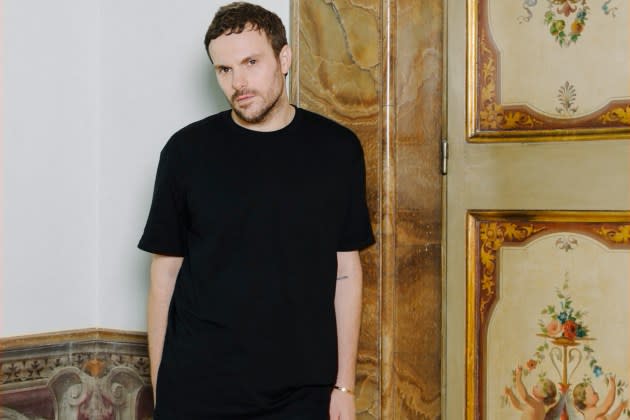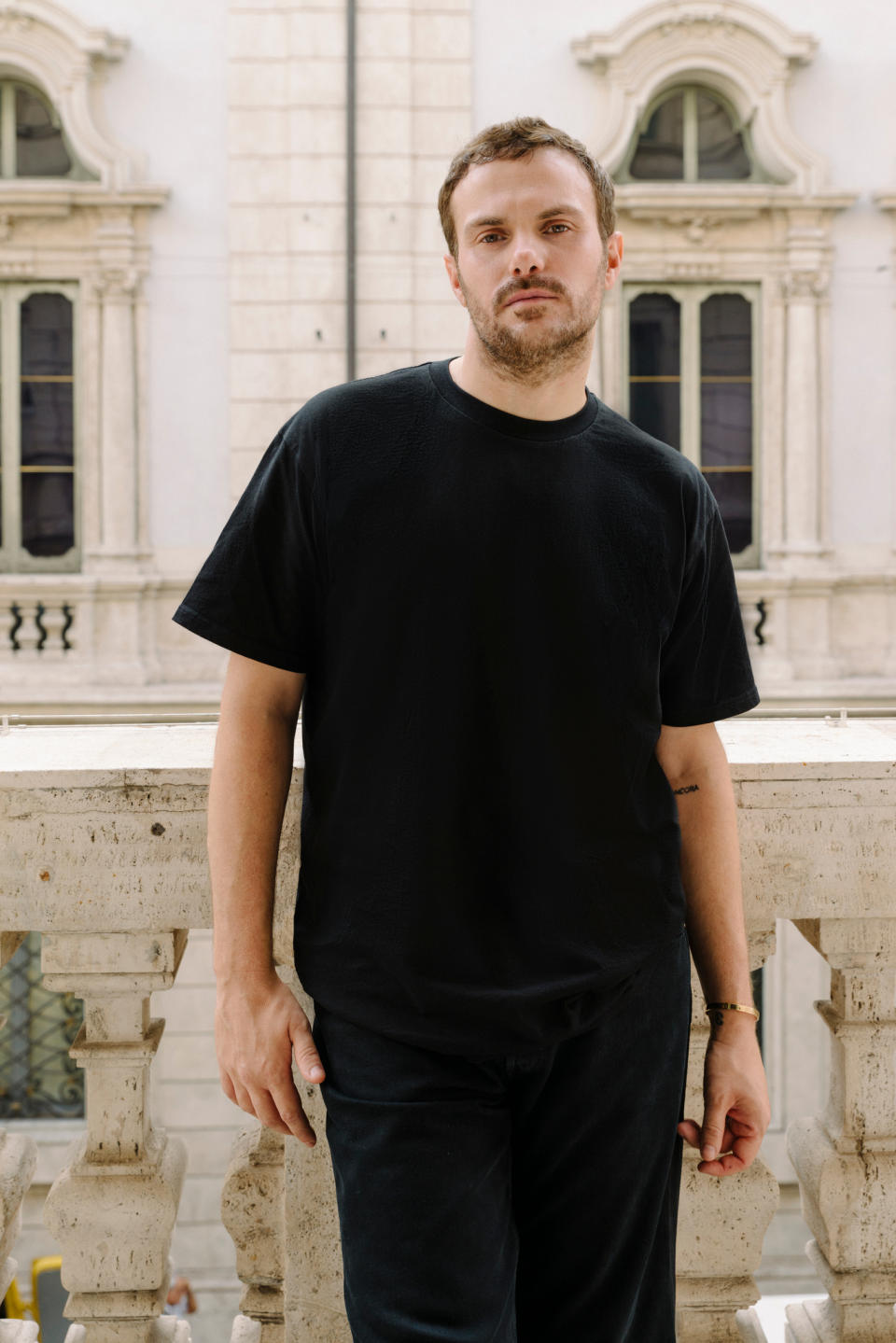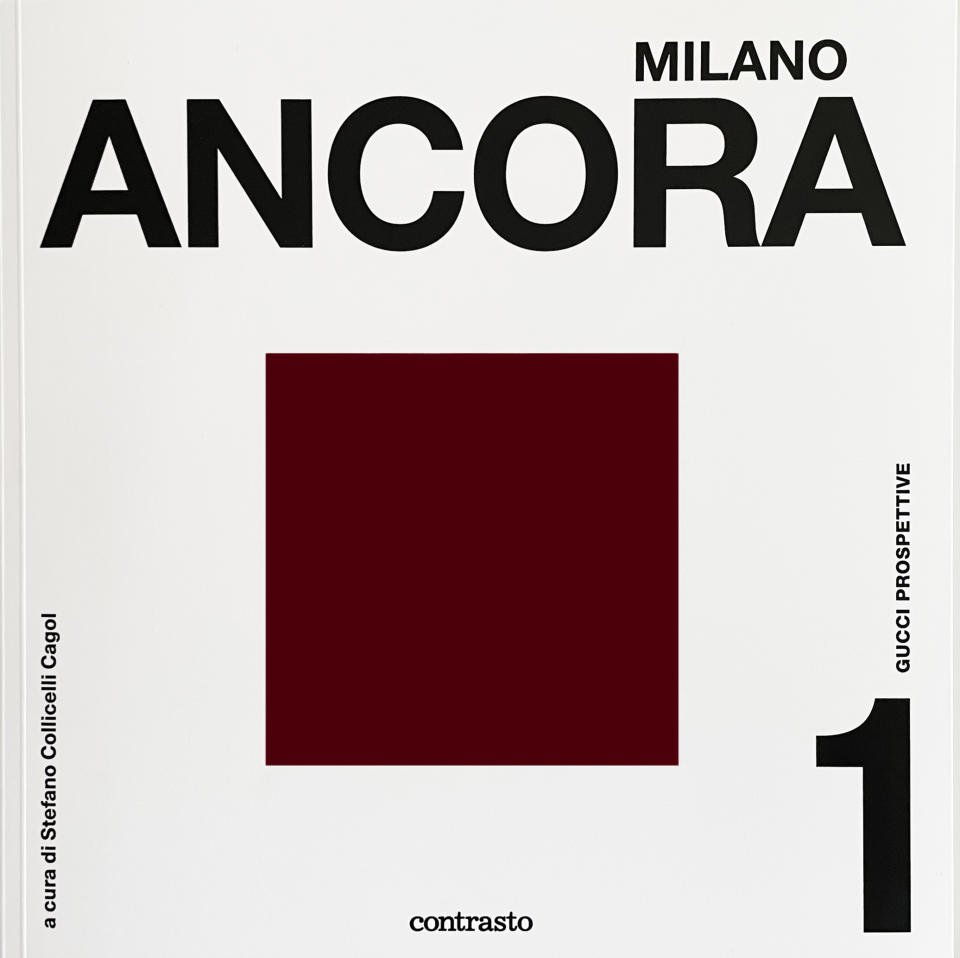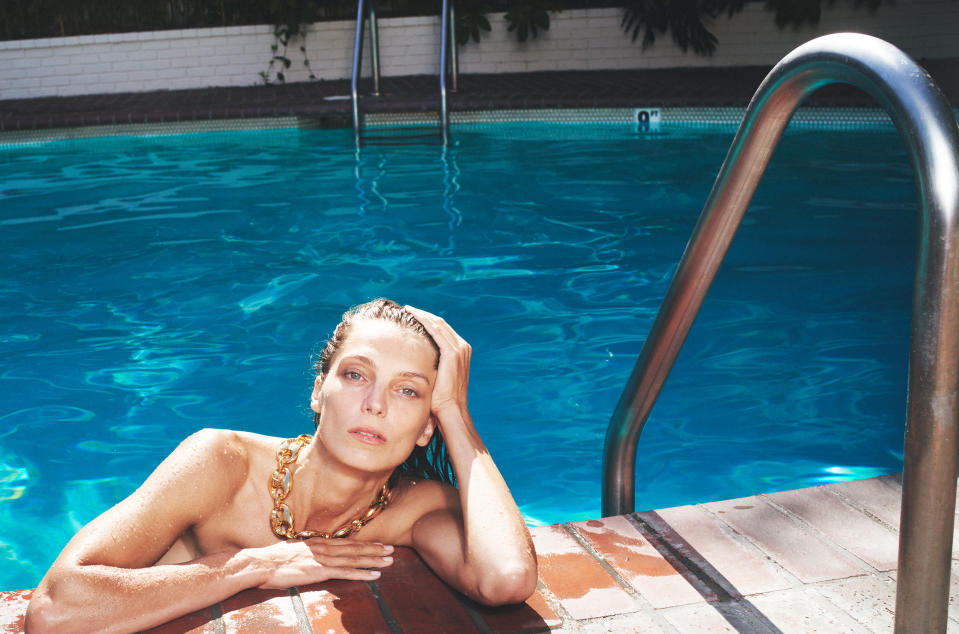Sabato De Sarno on Gucci’s New Imagery, Freedom and Show Debut

ROME — Tradition and modernity fuse under the frescoed vaults of the 17th century Palazzo Mancini in Rome, which is symbolic of Gucci’s current reinvention under creative director Sabato De Sarno.
Contemporary art stands out in his spacious office there, one particular piece by the Chicago-born Eric Stefanski hangs pride of place behind his sleek black desk, fashion books and sheets of paper neatly piled up. Green words dance on the peach orange canvas: “Everything Is Great, Everything Is S–t, Everything Is Exciting, Everything Is Boring…” and so on, with other adjectives that range from all right to dull.
More from WWD
The Golden Globes 2024 Generated Golden Numbers in Media Value With Gucci, Armani, Dior
Emma Watson and Benedict Cumberbatch Champion Sustainability in Prada's 2024 Re-Nylon Campaign
“I like words a lot, they have weight and a precise meaning, they convey emotions, so I like artists who use words, Robert Barry or [Alighiero] Boetti,” De Sarno said.
It’s not surprising then that he would select one specific word for his first womenswear collection for Gucci, to be shown in Milan on Friday: “Ancora,” or again in English.
“Ancora is a word that you use when your desire is not over yet, whether it’s a kiss or an embrace, or making love; it’s as if you own something and you want more of it.” He also said he wanted to “fall in love with fashion all over again — ancora.”
On his mood board, Ancora is spelled out in white on a red sheet of paper, surrounded by other red references — a Lucio Fontana slashed canvas, a red Jackie bag, shining red lips and Gucci’s monogram in red, among others.
To show exactly what kind of red he has in mind, since this is a shade that veers toward a deep rose red, almost burgundy, De Sarno pulled out the new packaging, which is sure to catch any loyal Gucci customer off-guard. Gone is his predecessor Alessandro Michele’s ornate green decorative pattern embossed onto paper bags — the new shopper is a liquid, almost shiny yet deep red with the brand’s name spelled out in white.
To De Sarno, however, this is not surprising. “Red is actually everywhere at Gucci. The very first Jackie bag was black with a red lining. I went to the Savoy Hotel, where Guccio Gucci worked [as a young man before founding his company] and the elevator, inside, is red,” he said.

It is obvious De Sarno has been doing some serious homework, as he recounts his excitement at discovering a treasure trove of unexpected pieces at Gucci’s Archive in Florence.
“Sure, there are the icons — the Jackie, the Bamboo bags — but I never imagined there would be this entire world of Gucci. On the lower floor, there is a lifestyle collection. I thought I would find a few gadgets but actually it’s a full-fledged home collection,” he marveled. “There are so many prints, the first foulards just as beautiful as the Flora and others by [Vittorio] Accornero, there is a world of animal prints that are part of the history, jewels and embroideries, which you would not immediately associate with Gucci.”
Case in point: a silver embroidered clutch in wool led the designer to include several embroideries in his spring collection. “Gucci has a beautiful history, and I feel it’s not been told enough, there are not that many books on Gucci.”
While those who know him swear by his skill at organization and describe him as creative but also concrete, a good planner and tenacious, De Sarno said he is actually very instinctive and that being organized helps him structure his life so that he does not have to miss out on anything. He lives between Rome, Milan and Brussels, where his husband works, and he always makes time for family and friends.
Wearing a practical and casual T-shirt over comfortable pants and Converse sneakers, all in black, De Sarno posed gamely for the WWD shoot, his manner friendly and easy. Hailing from Cicciano, a small town near Naples, the spontaneity and engaging ways Neapolitans are associated with are still there.
He is conscious of the role he plays at Gucci, underscoring that it’s a “great opportunity and a dream,” and is very serious about his job, aware of the task at hand as Kering chairman and chief executive officer François-Henri Pinault aims to refresh the brand and boost its performance. However, “I still want to be Sabato, have some fun, and there needs to be some degree of levity,” he claimed, saying he relished the freedom he has been given so far. “People imagine I have this long list of rules, limits or obligations, but that’s not true at all. I have been given free rein.”
Showing no apprehension ahead of his first show, he admitted, however, that he gets a bit more nervous when people ask him how he feels about his debut at Gucci. Otherwise, he said simply, “I am just doing my job, I like it, it’s what I want to do and every day I am surprised and amazed I am here.”
Named to his current post in January, De Sarno joined Gucci from Valentino, where he spent 14 years and rose through the ranks to become fashion director of men’s and women’s ready-to-wear in 2020.
He debuted in the fashion industry as assistant patternmaker at Prada in 2003 and left in 2006 when he joined knitwear manufacturer Annapurna until, two years later, he was named head designer of the women’s knitwear and jersey collection at Dolce & Gabbana.
“I never thought I would become the creative director of Gucci and I was very happy at Valentino, but I am very proud of this role. Gucci to me equals luxury and the first fashion piece I ever owned was a Gucci jacket by Tom Ford. I still remember I traveled to Rome to buy it with my friend, there was no Gucci store in Naples at the time, and luxury was really not part of our world. Television was the only way to see fashion for me back then,” he recalled.
Fashion allowed him to express himself. “I would dress up for a walk in the town and clothes would help me and with my friends we would check out how people would dress. Choosing what to wear defines yourself.”
Over the years, he has become a collector of fashion archival pieces, in addition to contemporary art works. Asked if he had a mentor, he said he “was crazy” for Gianni Versace when he was young, and that when the designer was killed in 1997, “it was a really very dark day” for him. Of Versace, he admired how he lived freely, he related to his being from the south of Italy, too; his moving to Milan, and his close-knit family links.
His own years living in Milan led him to the choice of location for his first Gucci show. His models will weave out of the Brera Art Academy and into the streets. “I used to have many friends studying in Brera and I liked to join them and look around the Accademia,” he reminisced, citing the Bar Jamaica in the ‘60s and ‘70s as “a place of interesting conversations, where artists and poets would meet. Milan is the city of opportunities, and I have always felt free there. It’s the city of fashion, but also of design, art and culture.”
To wit, he staged an event on Tuesday at Bar Jamaica to present the first volume of his “Gucci Prospettive” series, which will accompany each of his collections for the brand. Stefano Collicelli Cagol, director of the Luigi Pecci Center for Contemporary Art in Prato, interpreted the vision for the first chapter, named “Milano Ancora.”

“I like to give the same amount of space to Lucio Fontana as to an emerging artist, I like that balance,” said De Sarno, who aims to pay tribute to Milan with its art works, literature excerpts, music, cinema and fashion, narrating fragments of the city’s cultural and artistic history from the post-war period to the present day.
He revealed he is not much into set designs and the streets in Brera will “allow people to have the opportunity to see the clothes.” Inclusivity is a given in his opinion, while he prefers to focus on diversity — but especially through concrete facts and actions rather than just talking about it.
About the spring collection, he said he had a ‘60s and ‘90s silhouette in mind, “very short” looks, all daywear. “I didn’t want to show eveningwear. Gucci to me is more daywear, and outerwear is my passion — coats, peacoats….My ambition is to build an aesthetic message with an edited collection that is mindful of Gucci’s heritage and close to my own aesthetics.”
Again, he cited Fontana, who did not date his paintings but would write a phrase behind the canvas that would remind him of the period. “No date makes something immortal,” he opined. The process behind Fontana’s artworks was very complex, he explained, and people don’t really realize this. “I like things that appear simple but where the process is actually hyper-creative.”
De Sarno knows accessories are also key to Gucci’s business and hinted at revisiting the Jackie bag, referencing the icon’s forerunner from the late ’50s with the red lining and the original snap hook closure, not the piston.
While the week before the show Gucci’s Instagram was wiped clean, signaling a new chapter for the brand, De Sarno has enjoyed teasing a few images on his own handle, such as a post in mid-August reproducing a map of Milan, zooming in on Brera and, earlier that month, of Daria Werbowy posing for a Gucci jewelry campaign, photographed by David Sims at Chateau Marmont wearing only a bikini bottom on the side of the pool.
It gave a clue to his vision for Gucci but asked about the choice, De Sarno sounded more sentimental than strategic. “Daria was the first model I saw up close when I was working at Prada, it was a very nice moment, early on in our careers, with David, who photographed her at her debut and now again in this new phase for me.”

Best of WWD

